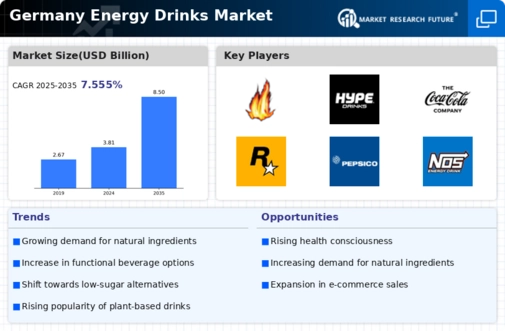Sustainability Initiatives
The energy drinks market in Germany is increasingly influenced by sustainability initiatives, as consumers become more environmentally conscious. Brands are adopting eco-friendly practices, such as using recyclable packaging and sourcing ingredients responsibly. In 2025, it is anticipated that around 40% of consumers will prefer brands that demonstrate a commitment to sustainability within the energy drinks market. This trend is prompting companies to invest in sustainable sourcing and production methods, which may enhance their brand image and appeal to a broader audience. Furthermore, transparency in ingredient sourcing and production processes is becoming a key factor in consumer decision-making. As sustainability continues to shape consumer preferences, the energy drinks market is likely to evolve, with brands that prioritize eco-friendly practices gaining a competitive edge.
Focus on Functional Benefits
The energy drinks market in Germany is increasingly emphasizing functional benefits, appealing to health-conscious consumers. Products that offer additional advantages, such as enhanced cognitive function or improved physical performance, are gaining traction. In 2025, it is projected that functional energy drinks will represent approximately 25% of total sales in the energy drinks market. This shift is driven by a growing awareness of health and wellness, prompting consumers to seek beverages that provide more than just energy. Brands are responding by incorporating ingredients like vitamins, amino acids, and herbal extracts, which may enhance the perceived value of their products. As a result, the energy drinks market is likely to see a diversification of product offerings, catering to various consumer needs and preferences.
Innovative Marketing Strategies
The energy drinks market in Germany is witnessing a transformation driven by innovative marketing strategies. Brands are increasingly leveraging social media platforms and influencer partnerships to engage with younger demographics. In 2025, it is estimated that digital marketing expenditures in the energy drinks market will account for over 30% of total marketing budgets. This shift towards digital engagement allows brands to create targeted campaigns that resonate with health-conscious consumers. Additionally, experiential marketing events, such as sports sponsorships and music festivals, are becoming prevalent, enhancing brand visibility and consumer interaction. The energy drinks market is thus evolving to meet the expectations of a digitally savvy audience, which may lead to increased brand loyalty and market share for those who effectively harness these strategies.
Increasing Demand for Convenience
The energy drinks market in Germany experiences a notable surge in demand for convenience-oriented products. Busy lifestyles and the need for quick energy boosts drive consumers towards ready-to-drink energy beverages. In 2025, the market is projected to grow by approximately 8% as more individuals seek portable solutions for energy replenishment. This trend is particularly evident among young professionals and students who prioritize on-the-go consumption. The energy drinks market is adapting by introducing single-serve packaging and innovative flavors that cater to diverse consumer preferences. Furthermore, the rise of convenience stores and vending machines enhances accessibility, making energy drinks a staple choice for those in need of immediate energy. As a result, brands are likely to invest in marketing strategies that emphasize the convenience factor, further propelling market growth.
Emerging Trends in Flavor Profiles
The energy drinks market in Germany is experiencing a shift towards innovative flavor profiles, reflecting changing consumer tastes. Traditional flavors are being complemented by exotic and unique options, appealing to adventurous consumers. In 2025, it is projected that the market for unconventional flavors will grow by approximately 15%, indicating a strong consumer interest in novel taste experiences. This trend is particularly prominent among younger demographics, who are more willing to experiment with new flavors. Brands are responding by launching limited-edition flavors and collaborations with popular food brands, which may enhance consumer engagement and drive sales. The energy drinks market is thus likely to see a diversification of flavor offerings, catering to the evolving preferences of consumers seeking distinctive and memorable taste experiences.


















Leave a Comment